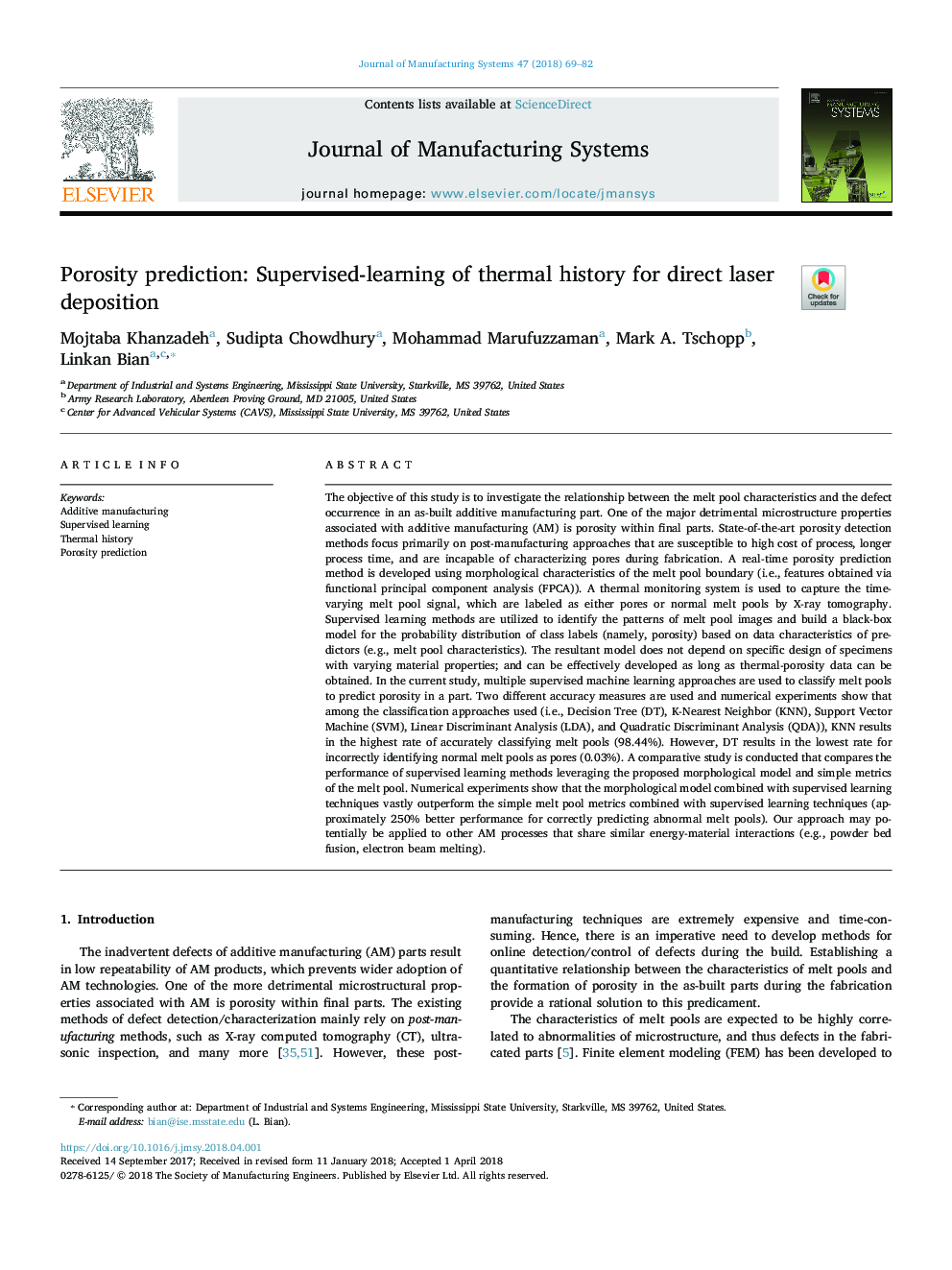| کد مقاله | کد نشریه | سال انتشار | مقاله انگلیسی | نسخه تمام متن |
|---|---|---|---|---|
| 8048270 | 1519246 | 2018 | 14 صفحه PDF | دانلود رایگان |
عنوان انگلیسی مقاله ISI
Porosity prediction: Supervised-learning of thermal history for direct laser deposition
ترجمه فارسی عنوان
پیش بینی پوسته: نظارت بر یادگیری تاریخ حرارتی برای رسوب مستقیم لیزر
دانلود مقاله + سفارش ترجمه
دانلود مقاله ISI انگلیسی
رایگان برای ایرانیان
کلمات کلیدی
تولید افزودنی، نظارت بر یادگیری، تاریخ حرارتی، پیش بینی قطبیت،
موضوعات مرتبط
مهندسی و علوم پایه
سایر رشته های مهندسی
کنترل و سیستم های مهندسی
چکیده انگلیسی
The objective of this study is to investigate the relationship between the melt pool characteristics and the defect occurrence in an as-built additive manufacturing part. One of the major detrimental microstructure properties associated with additive manufacturing (AM) is porosity within final parts. State-of-the-art porosity detection methods focus primarily on post-manufacturing approaches that are susceptible to high cost of process, longer process time, and are incapable of characterizing pores during fabrication. A real-time porosity prediction method is developed using morphological characteristics of the melt pool boundary (i.e., features obtained via functional principal component analysis (FPCA)). A thermal monitoring system is used to capture the time-varying melt pool signal, which are labeled as either pores or normal melt pools by X-ray tomography. Supervised learning methods are utilized to identify the patterns of melt pool images and build a black-box model for the probability distribution of class labels (namely, porosity) based on data characteristics of predictors (e.g., melt pool characteristics). The resultant model does not depend on specific design of specimens with varying material properties; and can be effectively developed as long as thermal-porosity data can be obtained. In the current study, multiple supervised machine learning approaches are used to classify melt pools to predict porosity in a part. Two different accuracy measures are used and numerical experiments show that among the classification approaches used (i.e., Decision Tree (DT), K-Nearest Neighbor (KNN), Support Vector Machine (SVM), Linear Discriminant Analysis (LDA), and Quadratic Discriminant Analysis (QDA)), KNN results in the highest rate of accurately classifying melt pools (98.44%). However, DT results in the lowest rate for incorrectly identifying normal melt pools as pores (0.03%). A comparative study is conducted that compares the performance of supervised learning methods leveraging the proposed morphological model and simple metrics of the melt pool. Numerical experiments show that the morphological model combined with supervised learning techniques vastly outperform the simple melt pool metrics combined with supervised learning techniques (approximately 250% better performance for correctly predicting abnormal melt pools). Our approach may potentially be applied to other AM processes that share similar energy-material interactions (e.g., powder bed fusion, electron beam melting).
ناشر
Database: Elsevier - ScienceDirect (ساینس دایرکت)
Journal: Journal of Manufacturing Systems - Volume 47, April 2018, Pages 69-82
Journal: Journal of Manufacturing Systems - Volume 47, April 2018, Pages 69-82
نویسندگان
Mojtaba Khanzadeh, Sudipta Chowdhury, Mohammad Marufuzzaman, Mark A. Tschopp, Linkan Bian,
